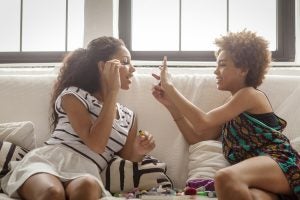
The science behind toxic inequities in beauty and personal care products
Jennifer McPartland, Ph.D., is a Senior Scientist with the Health Program.
Prominent incidences of environmental injustice in the public eye are typically place-based — from lead-contaminated tap water in Flint, Michigan to smokestacks lining Cancer Alley in Louisiana. For decades, communities of color and low income communities have confronted long-standing discriminatory practices and policies around land use, housing, and related issues that result in greater exposures to pollution and toxic chemicals.
While geography is a predictor of an individual’s health and well-being, environmental injustice and environmental racism extend beyond geography to include inequities in toxic exposures like in personal care product formulations. Beauty and personal care products marketed to women of color often contain more toxic ingredients than products marketed to white women. As a result, women of color are disproportionately exposed to toxic chemicals through these products.
A 2017 landmark article, The environmental injustice of beauty: framing chemical exposures from beauty products as a health disparities concern, by Ami Zota and Bhavna Shamasunder, puts a spotlight on this form of environmental injustice and the health implications for women of color.
- A 2016 study of Latina adolescents revealed higher levels of chemicals of concern including parabens, certain phthalates, and certain UV filters in their urine when compared to national averages for female adolescents.
- A 2012 study of women of color in the greater New York Metropolitan area found that more African-Americans (49.4%) and African-Caribbeans (26.4%) used hair products containing placenta or endocrine disrupting chemicals (EDCs) compared to white women (7.7%).
- A 2011 study of New York City residents, found those with the highest urine mercury levels were foreign-born Dominican women of reproductive age, and skin-lightening creams were identified as a source of exposure among highly-exposed populations.
Since the Zota and Shamasunder article, more research has been published describing the beauty injustice problem including:
- An initial 2021 pilot study found Black and Hispanic/Latina hairdressers working in Black and Dominican salons had higher levels of certain phthalates in their urine compared to the general population, including diethyl phthalate (DEP), a chemical associated with adverse reproductive and neurodevelopmental effects.
- A 2021 study examining six commonly used leave-in hair products used by Black women found that the products were all hormonally active.
- A 2018 study found 45 endocrine disrupting or asthma-associated chemicals in18 hair products used by Black women and girls, with two no-lye hair relaxers for children containing the highest levels of four endocrine-disrupting chemicals banned in the EU.
- A 2018 study on the use of certain hair products found an association with earlier menarche — a risk factor for breast cancer which research indicates is more aggressive in Black women.
While it’s up to businesses and policy makers to repair the broken systems that perpetuate beauty injustice, and to effectively address inequities around harmful ingredients and ensure that these products are safe for everyone, resources exist to help consumers take steps to minimize their exposure to harmful ingredients in these products. The Silent Spring Institute together with WEACT and Black Women for Wellness developed useful tips that women of color can take to reduce their exposures to harmful beauty ingredients in hair products.
Mounting evidence makes clear that the toxic ingredients in personal care products for women of color result in real, dangerous health impacts. It’s long past time for everyone to have access to the safest possible ingredients in their products.













2 Comments
As a licensed esthetician of 41 years and paramedically certified by the lare Dr. James Fulton of Newport Beach, Ca. I have been an intense researcher of cosmetic ingredients with the focus of never allowing my clientele to use a toxic product. Your article has shaken me to the core. To learn that racial discrimination has invaded the esthetic business is sickening and unacceptable. We all must rise up and protest and boycott any product line that engages in ingredient discrimination against any person of any color.
Unfortunately this is not surprising. POC are pushed into environmental risky areas, and due to falsehoods perpetuated by systemic racism in the medical and chemistry fields.